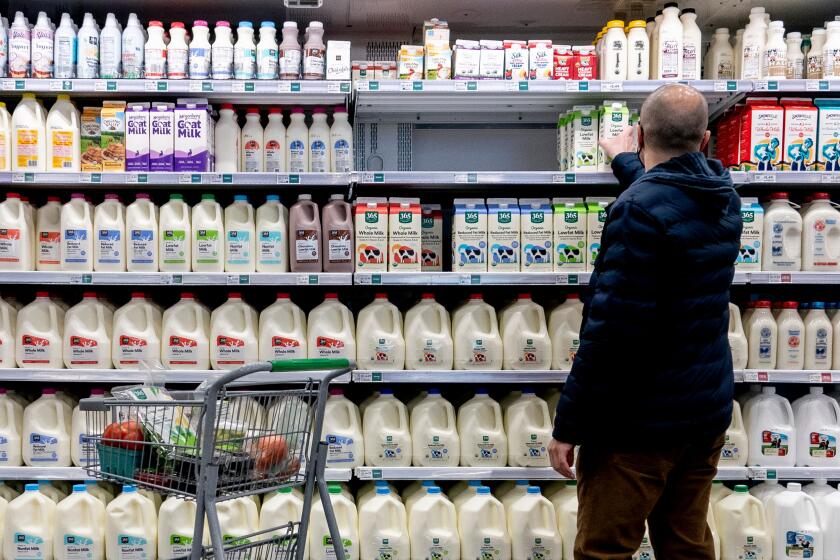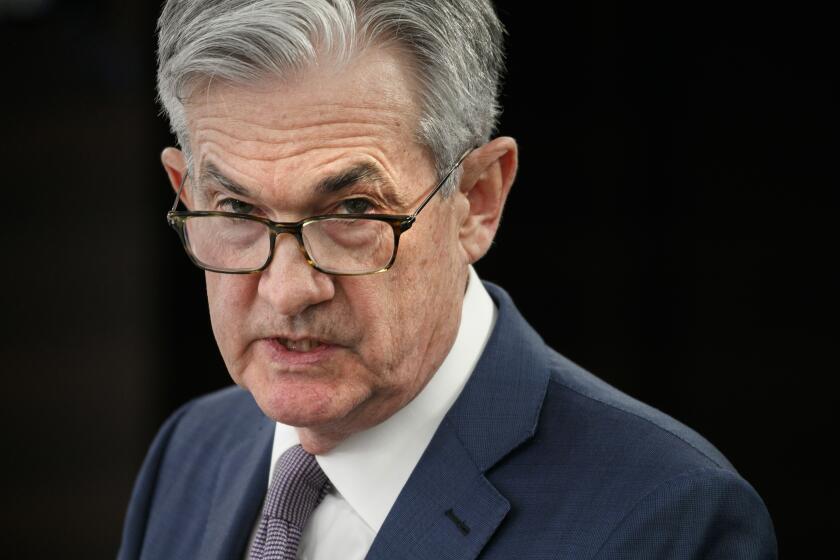Wage growth doesn’t drive inflation. So why is the Fed out to crush workers?

- Share via
Federal Reserve Chairman Jerome H. Powell and his colleagues have made major mistakes in their battle with inflation.
They instituted the fastest increase ever in interest rates despite evidence that many of inflation’s drivers, such as shipping logjams at the ports and the Russian invasion of Ukraine, were immune to interest rate changes.
They ignored the contribution of corporate profiteering, despite data clearly showing that business profits were expanding sharply — in other words, businesses were raising prices far more than they needed to cover rising costs.
Labor-cost growth has no meaningful effect on goods or housing services inflation.
— Fed economist Adam Hale Shapiro
But the most egregious error may have been their fixation on labor costs as a driver of inflation. The truth is that workers were the victims, not the culprits, in the inflation spike.
That conclusion is underscored by the latest government figures on inflation and wages. On Tuesday, the Bureau of Labor Statistics reported that consumer inflation fell to 0.1% in May, month over month, and 4% over the last year.
Get the latest from Michael Hiltzik
Commentary on economics and more from a Pulitzer Prize winner.
You may occasionally receive promotional content from the Los Angeles Times.
Earlier, the government had reported that hiring remained robust, though wages were falling on an inflation-adjusted basis.
Despite abundant evidence that the Fed’s inflation-fighting campaign has left many workers behind, Powell has consistently harped on the need to increase unemployment to bring inflation down.
“Reducing inflation is likely to require ... some softening of labor market conditions,” Powell said in his most recent news conference, following the Fed’s latest interest rate hike on May 3.
Powell treated every statistic showing labor market strength — low unemployment, “excess demand” for workers, persistent wage increases — as an obstacle to reducing inflation.
“Labor market conditions,” he said, “may have to soften a bit more to begin to see progress” against inflation. Barring that, he added, the Fed wouldn’t be willing to start cutting interest rates.
Hiltzik: These companies cynically used global crises to juice profits — and brought us inflation
The Fed has ignored how corporate profits drove inflation. That left PepsiCo, Tyson Foods and Procter & Gamble free to jack up prices and blame it on the pandemic and Ukraine war.
It’s hard to overstate how dangerous the Fed’s preoccupation with labor costs has been for the average American family. Powell tends to speak in the bloodless terms of academic economics, referring to “market conditions” and supply-and-demand curves. But those generalized formulas mask the potential for real pain and penury in American households in which efforts to “soften” labor conditions translate into layoffs and pay cuts.
Make no mistake: The people on the front line in this battle are not technocrats in air-conditioned rooms. They’re rank and file workers whose opportunities get liquidated in economic downturns.
Whether this approach will still hold won’t be known until Wednesday afternoon, when the Federal Open Market Committee announces its decision on interest rates. Most experts believe the Fed will pause in its more than yearlong cycle of raising interest rates. After the announcement, Powell will hold another news conference to discuss the committee’s thinking and outlook for the near future.
As I’ve been writing for nearly a year, the idea that wage increases drive inflation has been an enduring shibboleth among economists. Its most concise expression is the Phillips curve formulated in the 1950s by a New Zealand economist, which posits an inverse relationship between inflation and unemployment — that is, higher inflation is linked to lower unemployment and vice versa.
The most direct expression of this argument came last June from former Treasury Secretary Lawrence Summers, who said in a June 20 speech in London, as reported by Bloomberg: “We need five years of unemployment above 5% to contain inflation — in other words, we need two years of 7.5% unemployment or five years of 6% unemployment or one year of 10% unemployment.”
At the time, the unemployment rate was a historically low 3.6%. It was 3.7% in May, according to the Bureau of Labor Statistics.
Even though many respected economists recognize that if this relationship exists, it holds only in the very short term, the Phillips curve “has been the foundation of monetary policy for decades,” as Christopher J. Waller, a member of the Fed Board of Governors, observed in a March 31 speech.
The truth, Waller said, is that “if you simply plot inflation against the unemployment rate over the past 50 years,... there does not appear to be any statistically significant correlation between the two series.”
In other words, there’s no reason to assume that wage increases are a contributor to inflation. In an interview April 19 on NPR’s “Marketplace” program, Chicago Fed President Austan Goolsbee described the wage-price issue as a classic riddle along the lines of which came first — the chicken or the egg? “For sure, wage growth and price growth are tied together,” he said. The question is “are wages a leading or a lagging indicator of price inflation?” His answer was the latter.
That has been the case during the recent era of high inflation. Although wages have been rising over the last year in nominal terms, workers’ gains have been eroded by inflation, month after month.
According to the most recent wage report by the BLS, earnings increased by an average 3.4% in May, compared with a year earlier. Real wages, however — accounting for inflation — fell by 0.7%. Adjusted for inflation, average weekly earnings in May fell over the previous month by 0.085%, to $378.18 from $378.50.
Hiltzik: The Fed’s anti-inflation work is almost done, with an assist from the banking crisis
Economic growth will be a victim of the banking crisis, the Fed says, but will it be enough to quell inflation?
None of this could be a surprise to policymakers at the Fed. “Labor-cost growth has no meaningful effect on goods or housing services inflation,” economist Adam Hale Shapiro of the Federal Reserve Bank of San Francisco reported in a May 30 paper. At most, Shapiro calculated, wages accounted for 0.1 percentage point of the recent inflation surge.
Shapiro wrote that his findings “cast some doubt on the narrative that labor-cost growth is by itself an important driver of NHS [non-housing] price inflation.” He noted, as did Goolsbee, that “wage growth tends to follow inflation.”
That leaves the question of why Fed policymakers still act as though reducing employment and slowing, even reversing, wage growth will be good for the economy overall. One answer is that preserving employment is not part of the Fed’s legal mandate.
“Policies to support labor supply are not the domain of the Fed,” Powell acknowledged in a speech last November. Its monetary policy tools, he said, are aimed at controlling demand — raising interest rates quells the demand for housing by making mortgages more expensive and reduces consumers’ purchasing power by forcing credit card rates higher and empowering retailers to raise prices.
Powell has answered questions about the impact of the Fed’s interest rate hikes on the labor market by taking the long view. He describes the effort to reduce inflation as the quest for “price stability,” which he represents as the Fed’s ultimate goal.
“Without price stability, the economy does not work for anyone,” he said at his May news conference. “In particular, without price stability, we will not achieve a sustained period of strong labor market conditions that benefit all.”
In other words, if the Fed’s medicine is sufficiently harsh, the patients will eventually recover. But what if the pain is too great for some patients to live through?
More to Read
Get the latest from Michael Hiltzik
Commentary on economics and more from a Pulitzer Prize winner.
You may occasionally receive promotional content from the Los Angeles Times.













